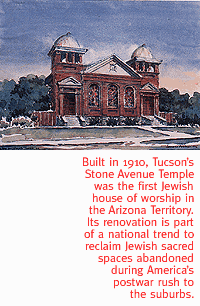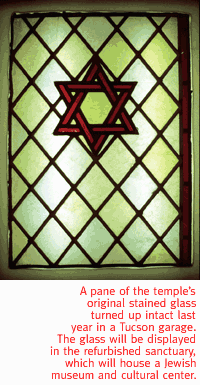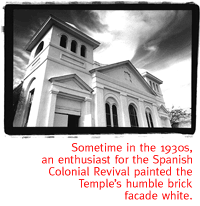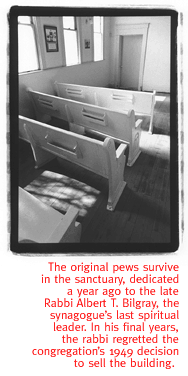
The Stone Avenue Temple Owes Its New Lease On Life To The End Of The 21st Century.
By Margaret Regan
IT WAS A strange piece of merchandise for a yard sale:
a pristine pane of yellow stained glass, emblazoned with a red
Star of David. But it was too good a deal to pass up. The woman
brought it home to her own garage, where it gathered dust for
years.
One day last February, a neighbor, Toby Anne Sydney, happened
to tell the woman's husband that she'd gotten involved in restoring
the Stone Avenue Temple, Arizona's first-ever Jewish synagogue,
in downtown Tucson. Shortly thereafter, the man stopped Sydney
in the alley.
 "I have something for you," he said. "I have a
piece of stained glass and I dreamed it belonged in that old temple
you're restoring."
"I have something for you," he said. "I have a
piece of stained glass and I dreamed it belonged in that old temple
you're restoring."
"At first I thought, 'This guy's crazy,' " Sydney said.
"But he brought out this stained glass and my jaw dropped.
I had a strong feeling that it belonged to the temple."
Sydney hurried the glass over to the Rabbi Albert T. Bilgray,
who lay dying in the hospital. The rabbi had been the last spiritual
leader in the downtown temple, and he recognized the glass from
the synagogue windows.
"He was ill, but he smiled and said, 'That's not an accident.'
He just felt so strongly about this building being saved."
 Today, the rescued glass is encased in a protective wood frame
and displayed as a sacred object d'art in a show about reclaimed
synagogues at the Tucson Jewish Community Center. If its fortunes
have changed for the better, so has the luck of the little synagogue
that was.
Today, the rescued glass is encased in a protective wood frame
and displayed as a sacred object d'art in a show about reclaimed
synagogues at the Tucson Jewish Community Center. If its fortunes
have changed for the better, so has the luck of the little synagogue
that was.
At the lower edges of downtown, just south of a front porch with
reindeer dashing across the roof, the distinctive white-washed
building gleams in the sun. Most of the time the place is locked,
and on a gusty morning recently, a lonely tumbleweed blew into
the iron fence in the front yard.
It's a proud building, though, what with its rounded towers and
trio of arched front windows, and it sits in proud company. Planted
on South Stone's ecumenical corridor, it's tucked among some of
Tucson's earliest religious institutions--San Agustín
Catholic Cathedral and the Primeria Iglesia Bautista on the north,
and the Prince Chapel African Methodist Episcopal on the south.
The white-domed building, just north of the Prince Chapel parking
lot, once upon a time was Temple Emanu-El.
"This was the first place of Jewish worship in the state,"
said Joyce Becker on a recent morning. Like Sydney, Becker serves
on the board of the Stone Avenue Temple Project, a nonprofit that
bought the building in 1995 and has begun a restoration, with
plans to convert the old place into a Jewish museum and cultural
center. Unlocking the doors and de-activating an alarm, Becker
looked around the spic-and-span sanctuary, a white-painted room
of elegant simplicity. The original pews stood neatly in rows
facing the bimah, the recessed enclave where the Ark once was
stored and where the rabbi read the Torah. Light poured in from
the rows of windows on the north and south walls, puddling on
the wood plank floors.
"They had an open house here one day," Becker said.
"I saw it and thought, 'This is a beautiful building.'
For many Tucson Jews, the once forlorn building exerts a powerful
emotional pull. Becker has no memory of services in the synagogue,
but she says her parents do. "As a child, I probably came
here in the early '40s...I would love to show the connection of
the early pioneers to Tucson and Jewish history."
Becker's family was at the tail end of a long line of Arizonans
who worshipped in the little building. In a lecture at the JCC
last month, architect Corky Poster, whose firm has drawn up tentative
restoration plans, gave a quick survey of the temple's up-and-down
history.
"Jews first came to Arizona in small numbers in the mid
1800s," Poster said. "They were small merchants passing
through who decided to stay."
Tucson Jews began meeting for worship in private homes around
the 1880s, but near the turn of the century, the Hebrew Ladies
Aid Society determined to build a permanent home. Commemorated
in an historic photo that now hangs inside the Temple, the stalwart
Ladies included women with such archetypal Tucson names as Drachman,
Mansfeld and Steinfeld. It was Eva Steinfeld who in 1886 bought
the synagogue's plot of land on South Stone, just north of 17th
Street. But the actual bricks and mortar were not laid until some
24 years later, when a little-known Tucson architect by the name
of Ely Blount composed his classical revival design. At a cost
of $4,712, the synagogue, dubbed Temple Emanu-El, opened on the
eve of Rosh Hashanah in October 1910.
 "It became an important part of the Jewish community,"
Poster said, acting as the center of Tucson's reform Jewish life
for decades. (A separate conservative congregation, Anshei Israel,
branched out of the temple.) Old confirmation pictures, full of
beaming young women in long white dresses and grinning young men
in suits and ties, line its freshly painted walls. There's even
a picture of African-American choir singers, visitors from neighboring
Prince Chapel, crowded onto the bimah with synagogue members.
"It became an important part of the Jewish community,"
Poster said, acting as the center of Tucson's reform Jewish life
for decades. (A separate conservative congregation, Anshei Israel,
branched out of the temple.) Old confirmation pictures, full of
beaming young women in long white dresses and grinning young men
in suits and ties, line its freshly painted walls. There's even
a picture of African-American choir singers, visitors from neighboring
Prince Chapel, crowded onto the bimah with synagogue members.
After 39 years, four decades of bar mitzvahs and weddings and
funerals, the congregation up and moved to the 'burbs--way out
East on Country Club Road. It continued to thrive as Temple Emanu-El
in the new location, while the beloved old synagogue began a circuitous
path to tumble-down. It's been home to a Mexican radio station
and at least 14 churches, including a Baptist church complete
with baptismal pool. A crucifix remained on the front pediment
until 1994. A Los Angeles couple, Fred and Harriet Rochlin, writers
with an interest in pioneer Jewish history, bought the place to
keep it from the wrecking ball; but maintenance was minimal, Sydney
said, and the building deteriorated.
In recent years, the temple served downtown's major contemporary
constituents, artists and the poorest of the poor. The intrepid
Meta Theatre company occupied it in the early 1990s, making a
stage out of the sacred bimah. Underneath the old sanctuary, a
dirt crawl space gave shelter to homeless looking to come in from
the cold.
The Stone Avenue Temple Project bought the place for $122,000
from the Rochlins in 1995, much to the relief of Rabbi Bilgray,
who had come to regret the decision to sell. Several years before
his death in March 1998, he told a reporter, "We made a terrible
mistake. We were penny-wise and pound foolish."
THE RABBI MIGHT have been pleased to know that along with
the found stained glass came a triple stroke of good luck. In
January, the Stone Avenue Temple got an unlikely presidential
imprimatur.
During his State of the Union Address, President Clinton told
Americans about a new historic preservation initiative spearheaded
by Hillary Clinton. Called the Save America's Treasures
campaign, it aims to celebrate the millennium by restoring the
nation's architectural jewels. Tucson's own temple, located within
the Barrio Historico National Register District, is on the priority
presidential list as a model project.
"The National Trust for Historic Preservation was asked
to give the White House a list of projects that the millennium
fund could help," said Marty McCune, Tucson's historic program
administrator. "They wanted prototype projects. They decided
to use the Stone Avenue Temple as an example."
It's unclear whether the designation will unleash a flood of
federal dollars toward Tucson, Sydney said, but she noted the
Breed Street Shul, a Los Angeles synagogue restoration project,
has already gotten $15,000 through the millennium plan.
And the Tucson Stone Avenue Temple Project recently got some
state money: an Arizona State Heritage Fund Award preservation
grant in the amount of $118,000. Sydney said the grant requires
that the nonprofit raise $60,000 in matching funds, and another
$20,000 of in-kind donations.
 "It's a very competitive process to get those grants,"
noted McCune. "It means they're a worthy project." Fund-raising
is still underway, but Sydney hopes construction will begin in
the spring.
"It's a very competitive process to get those grants,"
noted McCune. "It means they're a worthy project." Fund-raising
is still underway, but Sydney hopes construction will begin in
the spring.
"We hope to finish the interior work by the end of the summer
and add disabled access. We've already used it, but it's not terrifically
comfortable. We'll re-do the heating and cooling."
Poster estimates total renovation costs at $400,000, for exterior
and interior. A small Tucson-Pima County Historic Commission grant
paid for the security fence, and a private citizen forked over
$3,600 to replace the leaky roof. Already the bare-bones building
has been rented out for bar mitzvahs and lectures, and the Project
board hopes the place will earn its keep through bookings for
weddings, concerts and the like. It will also house offices of
the Jewish Historical Society.
McCune said the building is eminently worthy of being restored
to use, citing "its size and position on Stone Avenue and
the community it represents--the first Jewish synagogue. The use
it will be put to, as a community resource, not just related to
the Jewish religion. The architecture is different. It lends an
interesting variety to the streetscape. An empty building is always
a bad thing...Anything that increases the activity level is good."
"Absolutely, we think it will help the revitalization of
downtown," added Becker.
THE THIRD PIECE of good luck came in the form of national
publicity. The story of the Tucson temple's transformation is
making a prominent appearance in a national traveling exhibition.
Called Urban Diaspora: Reclaiming Space, the show is about
the reclaiming of abandoned synagogues and Jewish community centers
throughout America. Organized at the restored D.C. Jewish Community
Center in Washington, right now it's at Tucson's own JCC. A fascinating
blend of architectural and social history, it chronicles the historic
preservation tales of a baker's dozen of synagogue renovation
projects, in places as different as New York's Lower East Side
and the Colorado mining town of Leadville.
The show provides a national context for the Tucson Jewish community's
decision to decamp its beloved synagogue, and the next generation's
efforts to restore it. As curator Alison Clarick Gottsegen recounts,
the Old World Jews were pushed from nation to nation by persecution.
But in America, like post-war Americans everywhere, Jews rode
prosperity out of their inner-city neighborhoods, and for years
they didn't look back. Their early religious buildings decayed,
much like the temple; but even distressed, they remain rich repositories
of immigration and urban history.
Like most of the European immigrants of the 19th and early 20th
centuries, the Jews built sacred places wherever they settled.
Their architectural styles reflected their points of origin and
local materials, as well as their continuing negotiations with
their adopted country. In New York in 1887, Eastern European Jews
were practicing their religion freely for the first time in their
lives, and they joyfully constructed an elaborate Gothic/Romanesque
synagogue complete with stained glass, pillars, and a rose window
on the front facade. (The surrounding neighborhood is now Chinatown,
and the restored synagogue has a new secular name, the Eldridge
Street Project.)
In Washington, decades later, Jews built a community center in
the heart of the government district: its classical pillars and
pediments blend inconspicuously with the capital's architecture.
 The distinctive architecture of the Tucson temple (called Tucson's
"Jewish Church" in a 1912 postcard on display) seems
to fall somewhere in between assertion and assimilation. It's
also a product of early 20th-century America's flirtation with
classical architecture, but it's given an original Southwest twist.
Its facade has a classical triangular pediment and three arched
windows between columns, but its grand twin towers echo the Spanish-style
towers at San Agustín Cathedral up the street.
The distinctive architecture of the Tucson temple (called Tucson's
"Jewish Church" in a 1912 postcard on display) seems
to fall somewhere in between assertion and assimilation. It's
also a product of early 20th-century America's flirtation with
classical architecture, but it's given an original Southwest twist.
Its facade has a classical triangular pediment and three arched
windows between columns, but its grand twin towers echo the Spanish-style
towers at San Agustín Cathedral up the street.
Poster said its original design was humble, with a clear relationship
to the region and its materials. Its foundation is made of black
volcanic stone quarried from A Mountain, and its walls are constructed
of local brick. But somebody, seized by the 1930s craze for Spanish
Colonial Revival, took the notion to paint its red bricks white.
Undoubtedly the anonymous painter thought to make the place more
grand, but Poster sniffs at the painter's "Moorish fantasy."
He hopes to restore the building to its original brick.
What's fascinating is that the rehabilitation of all these buildings--from
Tucson's neo-colonial classical to Leadville's plain wood to Baltimore's
Greek Revival--began independently of one another. A generation
that grew up in assimilated suburbs is following the same impulse
to reclaim what their elders abandoned. They're converting the
old synagogues back, though rarely into places of worship. They'll
be museums, cultural centers, and at least in one case, a recreation
center that will once again resound with the sounds of basketballs
on the rebound. What prompted the reverse exodus?
"We're all of the generation who don't feel Jewish roots
in America," mused Sydney. "We know European (Jewish)
history and biblical history. But that's geographically so far
removed it doesn't have the immediacy of this building. We have
a long history here (in America).
"While the Holocaust was a horrible tragedy, and those memories
need to be preserved, this represents a whole other strand of
Jewish history...a successful strand."
Urban Diaspora: Reclaiming Space continues through
Sunday, February 14, at the Tucson Jewish Community Center, at
Dodge Boulevard and River Road. Call 299-3000 for gallery
hours.
Marilyn J. Chiat, author of America's Religious Architecture:
Sacred Places for Every Community and adjunct professor at
the University of Minnesota, gives a free lecture at the JCC at
7 p.m. Thursday, February 4, entitled The Shul in the Golden
Medina: A History of Synagogue Architecture in America.
Anthony Veerkamp, of the National Trust for Historic Preservation
Western Regional Office, will speak at 7 p.m. Thursday, February
11, on Preserving Sacred Spaces: A National Perspective.
For information about the Stone Avenue Temple (564 S.
Stone Ave.), call 628-3668.

|





